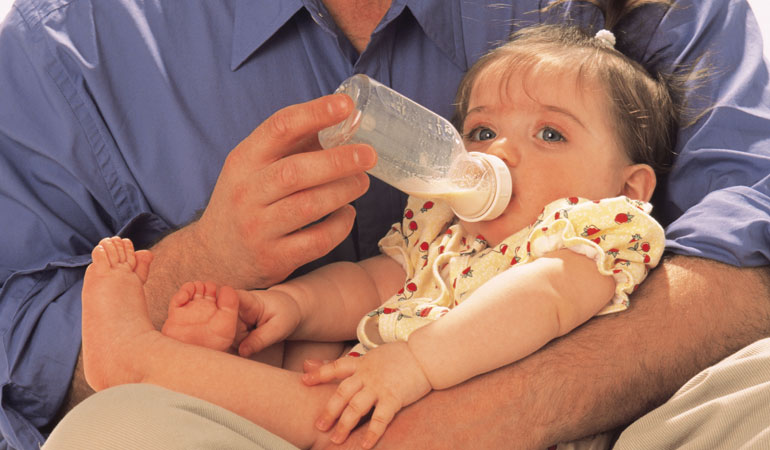With so many infant formulas available, it’s no wonder parents have trouble figuring out what to feed their babies. For those who must also consider the circumstances of their child’s story — prenatal nutrition, early care, family history — the task is even more challenging. Use these guidelines to help you and your child’s doctor make the best choice for your infant.
Standard Formulas
Health care providers generally recommend that an infant remain on an infant formula or be breastfed at least until his first birthday. While adoptive breastfeeding is a viable alternative for some families and an excellent choice for feeding an infant, most parents use a standard, iron-fortified, cow’s-milk formula. A child adopted at a later age, and who has significant malnutrition, anemia, or vitamin deficiencies, may need to stay on formula beyond 12 months to promote nourishment and bonding with his new family.
Standard cow’s-milk formulas contain lactose (a complex sugar) and naturally occurring proteins. While true lactose intolerance is rare in the first year, some infants are born unable to digest lactose. For these children, a lactose-free formula is the answer.
Soy Formula Use
Pediatricians may recommend formulas that are milk-free for infants who have symptoms of spitting, water loss through bowel movements, gas, and irritability. Most commonly, soy formulas are used when a milk-free diet is recommended, as these do not have milk protein. Parents choosing to feed their child a vegetarian diet may also use a soy formula. Some caveats:
- Some infants become very constipated on soy formulas, and need help passing stools.
- Infants with hypothyroidism should never be fed soy formulas, as soy protein may interfere with the absorption of thyroid hormone medication.
- If there is a known family history of food allergies or formula intolerance, your health care provider may recommend that you start with a soy formula from the time of adoption.
- In some cases, a child needs a low-lactose formula, which contains milk protein. As with soy formulas, low-lactose formula is usually recommended for infants who are fussy if fed a traditional milk-based formula.
Preparing the Bottles
When considering adoption and baby formula, it’s best to maintain your baby’s current formula for at least a short period of time after you adopt him. Usually, the hospital, orphanage, or foster home can tell you the exact type of formula used and how your baby likes it prepared. If you decide to change formula, or need to change to one more readily available in the U.S., you can do it gradually, by preparing bottles that contain a mix of the old and new formulas.
Most infant formulas come in three forms: ready to feed (no preparation needed), liquid concentrate (water must be added, usually in equal parts), and powder. Cost and convenience vary, depending on the brand and form, so choose the one that seems right for your child.
In general, plain tap water can be safely used to prepare bottles, although there is a risk of lead exposure from the pipes. Use only cold water, and run the water for two minutes before adding it to bottles. If your family gets water from a pond or a well, it should be boiled.
Although many families warm bottles before feeding, babies can generally tolerate formula at room temperature. Never warm formula in a microwave oven, as uneven heating could scald your infant. After each feeding, throw away leftover formula — don’t save it for the next feeding.
Cow’s milk, except in a formula compound, should never be fed to babies under a year of age. It has been shown to cause anemia, as well as increasing the risk of intestinal bleeding.
New Formula Features
Emphasis is being put on the additives that make formulas more like breast milk. Some are supplemented with prebiotics, carbohydrates that help the digestive system to grow bacteria that are beneficial in developing a strong immune system. Another common additive is nucleotides. These are the building blocks of DNA, and are thought to help with disease resistance. As with adult foods, antioxidants are helpful in the protection against injury to cells. DHA and ARA are fatty acid nutrients that naturally occur in breast milk, and which enhance brain and eye development. Most cow’s-milk formulas are fortified with these two nutrients.
The Toddler Years
Toddler formulas contain more vitamins and minerals than plain cow’s milk, and they are not routinely recommended. However, such a formula may be useful for a child who was inadequately nourished in his first year of life, and who may need important supplements for “catch-up” nutrition. Goat’s-milk formulas are not recommended, as they are low in vitamin D and folic acid.
Do not make your own formula for your infant, as it may be difficult to digest, and it may put a strain on your child’s developing kidneys.
Vitamin D Deficient?
New recommendations by the American Academy of Pediatrics state that infants and children should consume 400 international units (IU) of vitamin D each day. Fewer children are spending time outside, and those who do are (we hope!) wearing sunscreen to prevent skin cancer — sunscreen that blocks the making of vitamin D in the skin. Since this vitamin is important in building bones, supplementation is recommended, unless a child is drinking 32 ounces of formula each day.
Supplements are easily given through vitamin drops for infants and a chewable multivitamin for older children. Vitamin D is naturally found in oily fish (such as salmon), cheese, and egg yolks.
More information is available about vitamin D, and other nutritional topics, on healthy children.org.



